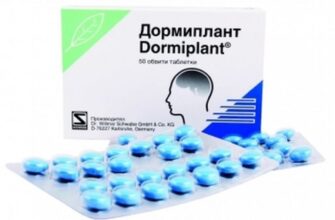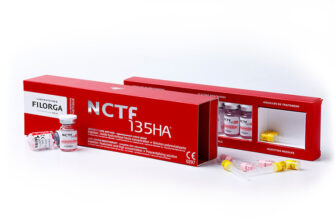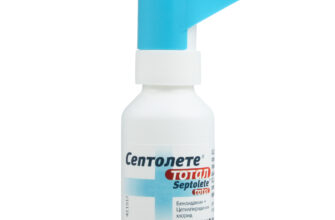Review of the best according to the editorial board. On the selection criteria. This material is subjective and does not constitute advertising and does not serve as a purchase guide. Before buying, you need to consult with a specialist.
If we consider the human body as a collection of cells, then it is surprising to find that we are not alone. In addition to our cells in the body, there are a huge number of other living things, which are called normal intestinal microflora. The number of these permanent settlers is measured in thousands and hundreds of thousands of trillions. The number of only species of microbes living in the intestine reaches 10 thousand.
If you remember that each type of microorganism can have several strains, that is, subspecies that differ in cultural and biochemical properties, then you can safely multiply the number of species by 7 or 10 times. And almost all of this variegated composition is localized in the large intestine. There are few microorganisms in the small intestine, because the environment there is mostly acidic. But in an alkaline environment, the number of microorganisms increases tens and hundreds of thousands of times. Most of all in the large intestine are anaerobic microorganisms, that is, those that do not require oxygen for their metabolism. But can't our body do without a population of microbes? No, he can not. That's what they're for.
- Why are microbes needed?
- Why is the microbiota disrupted?
- What factors are we talking about? Here they are:
- Why are prebiotics needed?
- What are prebiotics?
- 'Passport' of prebiotic
- Some prebiotic drugs
- Rating of the best prebiotics
- Lactulose (Duphalac, Portalac, Romfalak, Normase)
- Gastrointestinal tract Transit prebiotic
- Hilak-Forte
Why are microbes needed?
Remember that the collection of microorganisms that inhabit our gut is called the gut microbiota. Therefore, this term can sometimes be freely used. So, the function of this microbiota is vast and varied. They:
- help to provide a person with energy and food (no matter how strange it may sound);
- give energy with the help of some of their waste products;
- stimulate the immune system and primarily local;
- stimulate the formation of antibodies;
- control and regulate intestinal peristalsis, that is, the quality of contractions;
- participate in detoxification and removal of foreign toxic substances;
- activate drugs that have entered the intestines;
- destroy substances with mutational potential;
- improve the ionic composition of the epithelium zone and the physicochemical qualities of this zone;
- prevent carcinogens and the effect of toxic substances on the intestinal epithelium;
- prevent the multiplication of viruses and remove them;
- provide sources for the formation of fats and glucose;
- synthesize vitamins of group B, as well as pantothenic acid.
The list goes on and on. The following can be said with confidence. A person with a completely sterile colon will not be viable.
Why is the microbiota disrupted?
A person lives in an aggressive world. And over the past one or two centuries, a colossal number of external physical and chemical factors began to influence its life. There are also various internal factors such as illness and dietary habits. They also disrupt the balance of the gut microbiota.
What factors are we talking about? Here they are:
- uncontrolled use of antibiotics as self-medication;
- the use of drugs such as hormones, cytostatics and immunosuppressants, radiation and chemotherapy, operations;
- violation in the diet. First of all, this is an abundance of preservatives that protect refined food from spoilage, and have a very harmful effect on the vital activity of intestinal microbes: these are dyes, lack of dietary fiber, fast food.
- stress and chronic neuroses;
- acute intestinal infections such as dysentery, salmonellosis, rotavirus infection;
- low immunity, due to frequent colds,
- violation of the body's biorhythms associated with frequent travel and flights (jet lag);
- various chronic diseases, and functional disorders, disorders of the intestinal motor function.
An example of a classic diagnosis is spastic or atonic constipation, biliary dyskinesia.
How to deal with this situation after identifying and eliminating the risk factor? If correctly, then the treatment of the pathology that led to dysbiosis is prescribed. Conditionally pathogenic flora is rendered harmless, which has kneaded normal microorganisms, then eubiosis is restored, that is, the intestine is re-colonized with normal microorganisms, and then this state is maintained. And so probiotics and prebiotics are of enormous importance for eliminating dysbiosis and restoring intestinal health. We can say that without them there will be nothing: no health, no life.
Why are prebiotics needed?
On almost every health food website, you can read the simple difference between prebiotics and probiotics. The difference is the same as between backstory and history: prebiotics prepare and probiotics inhabit.
Probiotics are living microorganisms whose task is to multiply and populate. And prebiotics are food that was brought before them. It is quite obvious that for humans and for microbes, food is needed completely different, and prebiotics for our body do not represent any nutritional value.
Basically, prebiotics are represented by various fibers. We do not have enzymes to digest them. We can give an example of such fibers that we regularly consume, but which leave the intestines unchanged: these are mushrooms.
As you know, partly the fungal body consists of chitin, the very same that makes up insect shells. Our body takes everything from mushrooms except chitin, since we do not have the chitinase enzyme. In the same way, we cannot eat wood, because wood is cellulose, and we do not have cellulose as an enzyme. But it is present in abundance in various beetles – woodworms, sawers, bark beetles, and other representatives of arthropods.
But, nevertheless, such fibers, which reach the intestine unchanged, “with a bang”, are found by newly colonized microorganisms. After they are fermented, various short-chain fatty acids are formed, which are very important for improving bowel function. First of all, they maintain the acid-base state, improve the integrity of the walls, and reduce their permeability. As a result, numerous toxins do not penetrate the bloodstream through the small intestinal wall. This reduces the likelihood of developing allergies, the development of autoimmune and oncological diseases.
For example, the short-chain fatty acid butyrate significantly reduces the incidence of colorectal cancer when present in normal concentrations.
What are prebiotics?
So which of the representatives of prebiotics are known to modern science, which at first glance seem useless for a person, but are in great demand for his 'lodgers'?
There are many classifications of prebiotics, both in terms of chemical structure and origin. Here are some of them:
- varieties of starches and starchy substances, inulin and other polysaccharides. Most inulin is found in Jerusalem artichoke, onions and chicory, as well as asparagus and fresh garlic;
- fructo-oligosaccharides, which are found in oats, ripe tomatoes;
- Galactose-oligosaccharides are the result of the breakdown of milk sugar, or lactose;
- there are a lot of them in soybeans, mangoes, berries, green dandelion stalks, from which salad is made, in rye bran.
Separately, mention should be made of oligosaccharides that a baby receives with breast milk, as well as lactulose.
We should not forget about monosaccharides such as xylitol and sorbitol, and long-chain sugars such as cellulose, pectins, found in apples and marshmallows.
Even various amino acids such as glutamic acid, valine, carotenoids can exhibit prebiotic properties. Separately, we can name various plant extracts: carrot, corn, pumpkin and others.
However, there are leaders in pronounced prebiotic properties. These include inulin, lactulose, and several other pure prebiotics. Plant products, leaders in the number of prebiotics, include: chicory, beans, artichoke, bananas, asparagus, peas, various cereals and onions, corn flakes.
Of course, medications and dietary supplements are also saturated with some prebiotics. How to choose from this variety what is most useful and shown?
'Passport' of prebiotic
If a person has a complete diet with all proteins, fats, carbohydrates and vitamins, but no prebiotics, then he will not have health either. Even if at the same time he is literally “ flooded '' with bifidumbacterin and other probiotics, then the microbes, the landing of which is thrown into the intestines, will have nothing to eat. Therefore, the diet should not work against microbes of normal microflora, but for it.
Before choosing a prebiotic, you must consider the strict requirements for it. Nutritionists know that:
- these compounds should not be destroyed in active gastric juice, and by pancreatic enzymes;
- they should not be adsorbed in the upper gastrointestinal tract;
- they must stimulate the reproduction of beneficial microorganisms.
Polysaccharides of cereals, vegetables and fruits, such as inulin, artificial disaccharides such as lactulose, and calcium pantothenate completely satisfy all these requirements.
It should be understood that pure prebiotics should be prescribed for the correction of dysbiosis, that is, for the purpose of treatment. In an ordinary healthy person, prebiotics should not be in the medicine cabinet, but on the dinner table. Cabbage, garlic, bananas, onions, asparagus, pistachios and cashews are considered the best sources of these fibers. If you add a little of these foods to your daily diet, your gut microbiota will soon respond gratefully. Immunity will increase, as will immunity to various infections.
Some prebiotic drugs
Finally, let's take a look at some of the prebiotic remedies available over the counter. As a rule, they are prescribed in the complex therapy of diseases of the gastrointestinal tract, as well as for the correction of dysbiosis.
We will deviate from the usual scheme, and will not describe separately the advantages and disadvantages, because prebiotics are not formally drugs. Therefore, the only drawback may be individual intolerance, or, for example, the high price or difficulty of acquiring this drug in pharmacies. It should also be said right away that acute intestinal obstruction may be a contraindication, since all prebiotics lead to an improvement in motility and the appearance of a physiological rhythm of defecation. After all, prebiotics are a medicine not so much for us as for our friends – microorganisms.
Rating of the best prebiotics
| Nomination | a place | Name of product | price |
| Rating of the best prebiotics | 1 | Lactulose (Duphalac, Portalac, Romfalak, Normase) | 83 rbl. |
| 2 | Gastrointestinal tract Transit prebiotic | 149 r | |
| 3 | Hilak-Forte | 257 r |
Lactulose (Duphalac, Portalac, Romfalak, Normase)
Prebiotic rating: 4.9
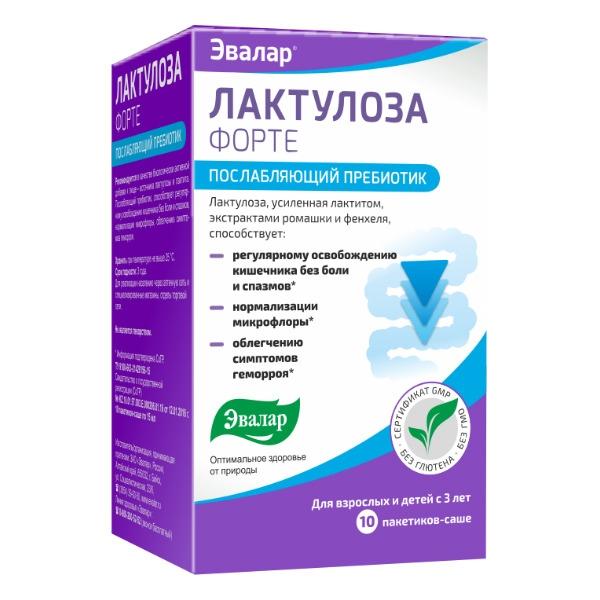
Although lactulose belongs to prebiotics, according to the anatomical and clinical classification, it belongs to the group of laxatives. In addition to dysbiosis, it is indicated for rehabilitation treatment after an acute intestinal infection, for constipation, as well as for liver failure. Lactulose is produced in the form of a syrup. These are bottles of 200, 500 ml, or 1 liter, or disposable sachets of 15 ml per pack. There are 10 such bags in a box.
It is a fairly viscous liquid that can have a light yellow or brown tint, and yet it is transparent. First of all, lactulose has an effect, being an osmotic laxative. By itself, without microbes, it cannot do anything. Only thanks to them, it can stimulate peristalsis, promotes the excretion of ammonia, which facilitates the condition in patients with hepatic insufficiency.
Lactulose is a prodrug. It is intensively consumed by the intestinal microflora, and the very low molecular weight acids that we have already mentioned above are formed. As a result, osmotic pressure increases, the volume of the contents of the large intestine increases, and specific receptors in the intestine are irritated. This increases peristalsis, softens the stool, and restores the normal rhythm of bowel movements. So lactulose copes with constipation.
In patients with severe hepatic insufficiency, and even with hepatic coma, lactulose, with the help of acidophilic sticks, transforms ammonia into a soluble form, which reduces its toxic effect. After all, it must be remembered that in chronic liver failure, the neutralization of ammonia in the liver does not occur, and ammonia itself is the end product of protein metabolism. Therefore, patients with such a severe pathology should very much restrict dietary protein.
Naturally, there are also contraindications to taking lactulose, for example, intestinal obstruction, or individual intolerance.
Lactulose is used in adults at an initial dose of 15 to 45 milliliters, and if constipation has resolved within 2 days, then the dose is reduced. The maintenance dose is approximately 2/3 of the initial dose. In the case of hepatic coma and encephalopathy, it is given in high doses, up to 45 milliliters three times a day, and then the dose is reduced, achieving regular bowel movements 2-3 times a day. Lactulose is produced by Solvay Pharmaceuticals, the Netherlands. The average cost of a 200 ml bottle is 300 rubles.
Gastrointestinal tract Transit prebiotic
Prebiotic rating: 4.8

This drug can be bought at a pharmacy, and its name fully reflects the essence of prebiotics: they transit through the gastrointestinal tract, benefiting microbes. It is powder in sachets, 10 sachets per pack. Each bag contains oligofructose, inulin, artichoke extract and green tea.
The prebiotic is produced by the domestic company ZAO Evalar, which specializes in various food additives. The average cost of a package is 182 rubles, the minimum is 153, and the maximum is 292 rubles. per packing. The action of this drug is standard for prebiotics: stimulating the life of bacteria, displacing harmful microflora, improving the passage of food through the intestines, removing toxins.
This is not a medicinal product, but a biologically active supplement, which contains soluble dietary fiber and fructose. The convenience of this tool is that you do not need to look for artichoke extract and inulin separately, that is, Jerusalem artichoke powder, but buy it all together in a bag.
Hilak-Forte
Prebiotic rating: 4.7
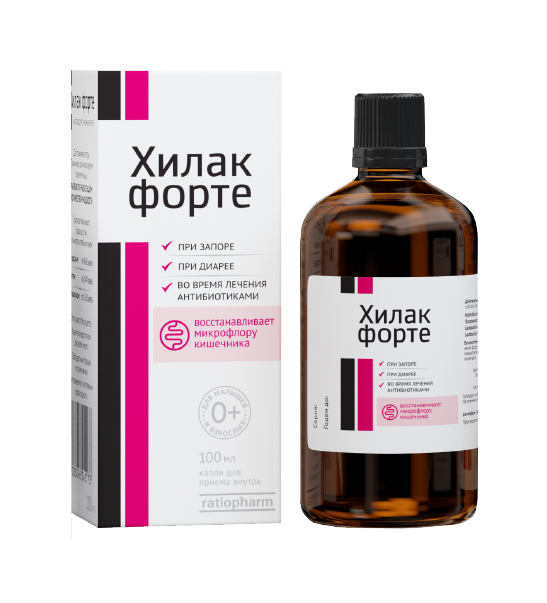
Finally, we should talk about one more truly unique product: Hilak forte drops. Why are they unique? Their task is to establish nutrition and improve the colonization of the large intestine by the newly introduced bifidobacteria and lactobacilli from probiotics. But Khilak-Forte does not apply to dietary fiber, and to none of the above types of prebiotics. These are the waste products of healthy intestinal microorganisms that form a familiar habitat for our friends.
According to the classification, it again had to be squeezed into anti-diarrhea drugs, although in fact this clear solution with a sour smell in its pure form is a drug that normalizes the intestinal microflora.
All other indications are secondary and associated with the active activity of normal microflora. So, an extended list of indications for the use of the drug Hilak forte will not only be constipation. These are gastritis and salmonella infection, dyspepsia and functional diarrhea, dermatitis and urticaria, and so on.
The preparation contains metabolic products of normal Escherichia coli, fecal streptococcus, and also several types of lactobacilli. It may come as a surprise that waste products stimulate the multiplication of new microorganisms. It is hardly possible to imagine that a room full of feces or debris will push for the continuation of the human race. But in microorganisms, everything is arranged differently. Their waste products, including lactic acid and its buffer salts, protect the multiplying colonies from the potential harmful effects of pathogenic microorganisms.
Thus, with the help of Hilak Forte, 'greenhouse' conditions are created for newly emerging microorganisms that have not yet fixed in the intestines. First of all, Hilak Forte stimulates the growth of acidophilus and lactobacillus flora. It is harmless, it is perfectly tolerated by both adults and children, it can be prescribed to pregnant and lactating women, and again, of all the contraindications, only rare individual intolerance is possible.
You need to use it either before meals, or during meals, 3 times a day. Adults – an average of 50 drops per appointment, children – 30 drops, and infants – 20 drops. It is produced in the form of drops for oral administration, and a bottle of 100 milliliters will cost 500 rubles. It is produced by the German company Ratiopharm.
In conclusion, you should contact gardeners and gardeners. Almost everyone, from Krasnodar Territory to Siberia, has an excellent opportunity to obtain high-quality prebiotic inulin. This is the cultivation of an earthen pear, or Jerusalem artichoke, on a personal plot. In addition to extremely useful root crops, this plant also pleases with beautiful yellow flowers.
Jerusalem artichoke is unpretentious, has a powerful deep root system, where edible tubers are formed. The tubers are knobby, and a little like a turnip, or a cabbage stump. Jerusalem artichoke tubers are very juicy, they surpass many vegetables in nutritional value. They do not have their own taste, and therefore can be successfully added to almost any salads. It can be dried. If the Jerusalem artichoke is fried, it may taste like fried potatoes, only sweetish. You can also make chips from Jerusalem artichoke, ground dried Jerusalem artichoke can be added to coffee drinks, you can make your own chicory drink. For example, this is done in the United States. Jerusalem artichoke is used to make a coffee substitute for diabetics.
Attention! This rating is subjective and does not constitute an advertisement and does not serve as a purchase guide. Before buying, you need to consult with a specialist.



